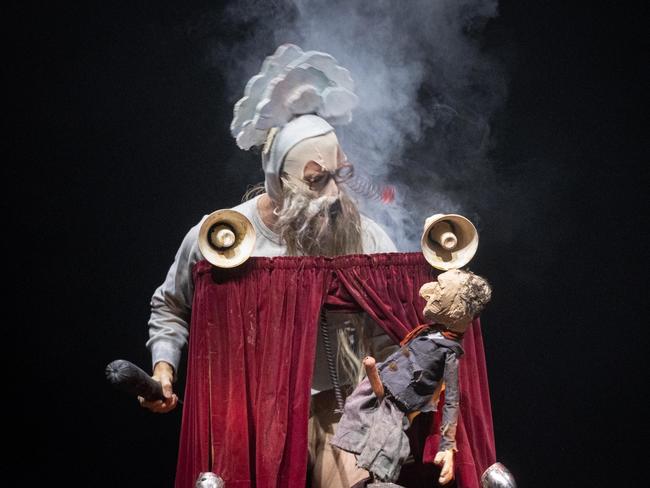The Sheep Song, 15 sheep bound for stage at Adelaide Festival
Fifteen animals will run, roam, bleat – and defecate – on stage in a piece of physical theatre about what it means to be human.

The last time sheep outnumbered actors during a performance in Australia was likely during the shooting of A Country Practice, but the animals were hardly at the heart of the drama. Not so for the 15 sheep who will run, roam, bleat – and defecate – on the stage of Adelaide’s Dunstan Playhouse in a piece of physical theatre about what it means to be human.
The Sheep Song, one of the headline productions at Adelaide Festival, will star six actors from Belgian theatre collective FC Bergman, including Jonas Vermeulen who will move as one of the flock before popping his head above the group and deciding that, actually, he would prefer to walk on two legs.
“I’m really among the sheep and one of them,” says Vermeulen. “We’re together, which is nice.”
As he speaks over Zoom from home in Antwerp, it’s amusing to imagine this handsome actor pretending to be a sheep, his tousled blond hair sticking to his brow under the weight of a hot sticky costume. And what about the sheep doing their business all over the stage? Is that not a hazard for the actor?
Vermeulen laughs at the question. “Well, they have no rules. They just do what they do, like real animals. It’s maybe even harder for the people who have to clean my costume afterwards.”
Vermeulen admits it can get quite slippery on stage when the sheep urinate but the actor has learned to use this to his advantage, especially in the beginning of the piece when he realises that to be a human he must stand on his hind legs.
“It’s supposed to look quite difficult as my sheep is searching for a way to find his balance. So that’s nice if I have some places on stage where I can use it (the pee) to lose my balance.”
Having performed the work across Europe, Vermeulen says one thing remains the same: the contrast between the animal and human condition. “It’s beautiful to just have sheep standing there and not caring about the context of a theatre, not caring about 300 people looking at them or not,” he says. “The human condition is the only one where we strive for certain things. We want to change, we want to adapt, we want to improve, we want to get better, or we want to become something that we’re not.”

From the beginning FC Bergman has been going off script in creating a theatrical language and a physicality that has been compared to the likes of Pina Bausch and Romeo Castellucci. Its six founding members – Aerts, Joe Agemans, Bart Hollanders, Matteo Simoni, Thomas Verstraeten and Marie Vinck – met studying theatre at the Conservatorium of Antwerp and in 2008 staged their first work, The Man Who Breaks Rocks, in an squatters’ warehouse among old petrochemical factories at the edge of the city. Aerts says the off-road theatre festival was basically held at a gypsy camp ground.
“They were fighting all the time over there,” he says, “and it was really crazy. But it was a very cool place to be because we could do anything we wanted; there were no restrictions.”
This work was the start of a “wordless” style they developed to subvert their traditional text-based actor’s training. These days they are just as comfortable with opera (Aerts is speaking over Zoom from Switzerland where the company is staging Montiverdi’s The Return of Ulysses to his Homeland at the Grand Théâtre de Genève). A regular at theatres and festivals across Europe, FC Bergman is resident at Antwerp’s Toneelhuis theatre. It also has a history of performing site-specific work; in The Land of Nod (2015) the company performed a show inside a recreation of the neoclassical Rubens room of the Antwerp Museum of Fine Arts.

That show is bound in June for the Biennale di Venezia, where FC Bergman will be given the Silver Lion award for theatre. A scene that was axed from The Land of Nod was the catalyst for The Sheep Song.
“One of these images was a little lamb that we brought on stage in this piece,” Aerts says. “It was such a strong image of this real live little sheep in this museum hall and we were all like ‘f--k, it’s too good’. If we start with this, the rest is in vain and we can’t top it. So we decided to leave [the sheep] out.”
They decided “do something about the sheep” about one year later but the project was derailed by cuts to arts funding in Belgium and the Covid pandemic. By the time they could finally come together, the sheep had legs.
“We never wrote a scenario so fast than with The Sheep Song because we were all coming with our backpack full of ideas and dramaturgical thoughts,” Aerts says. “In less than a month we had this scenario.”
Much of the company’s work takes its cues from religion “and a sheep, by excellence, is a religious symbol and the religious metaphor for mankind”. One’s mind also wanders to George Orwell’s Animal Farm (“four legs good, two legs bad”) and the human thirst for power.
“You would say The Sheep Song is a fairytale; it’s not possible for the sheep to become human,” Aerts reasons. “You would think the most difficult part is walking on two legs. But the most difficult part is becoming a human in his thoughts.
“The sheep doesn’t stop and has difficulty feeling satisfied. That’s the same with our lives and with our searching for what we should be or what is our most ideal way of being.”
Since it premiered in 2021, The Sheep Song has been performed across Europe with animals from local pastures, each flock bringing its own personality.
“In Lyon (in France) you had all these little brown sheep and our sheep as this enormous white furry beast between them,” Aerts smiles. “And then at the very end we thought they would run but they didn’t. It was as if they were frozen.”
The Adelaide Festival has purchased 15 border leicester – merino sheep at $145 a head from a stockyard agent and the animals are currently grazing on a farm north of Adelaide surrounded by paddocks and gum trees. Come performance week they will be transferred to two large pens in a workshop at the Adelaide Festival Centre where they will be overseen by a farmhand and a large animal vet. After their four shows at the Dunstan they will retire to a farm in the Adelaide Hills.

While audiences may catch a whiff of the rich earthiness of farm animals in the theatre, they should not worry about the animals toppling off the stage – this has never happened.
“At the front of the stage we have a conveyor belt so if the sheep come too close then they go away,” Aerts says. “It’s a bit like with rabbits, they really stay in the light. Except in Spain where the sheep seem excited by the darkness. Most of the other sheep in the world stay in the light.”
The Sheep Song is showing as part of the Adelaide Festival at the Dunstan Playhouse, Adelaide Festival Centre, March 16-19.


To join the conversation, please log in. Don't have an account? Register
Join the conversation, you are commenting as Logout